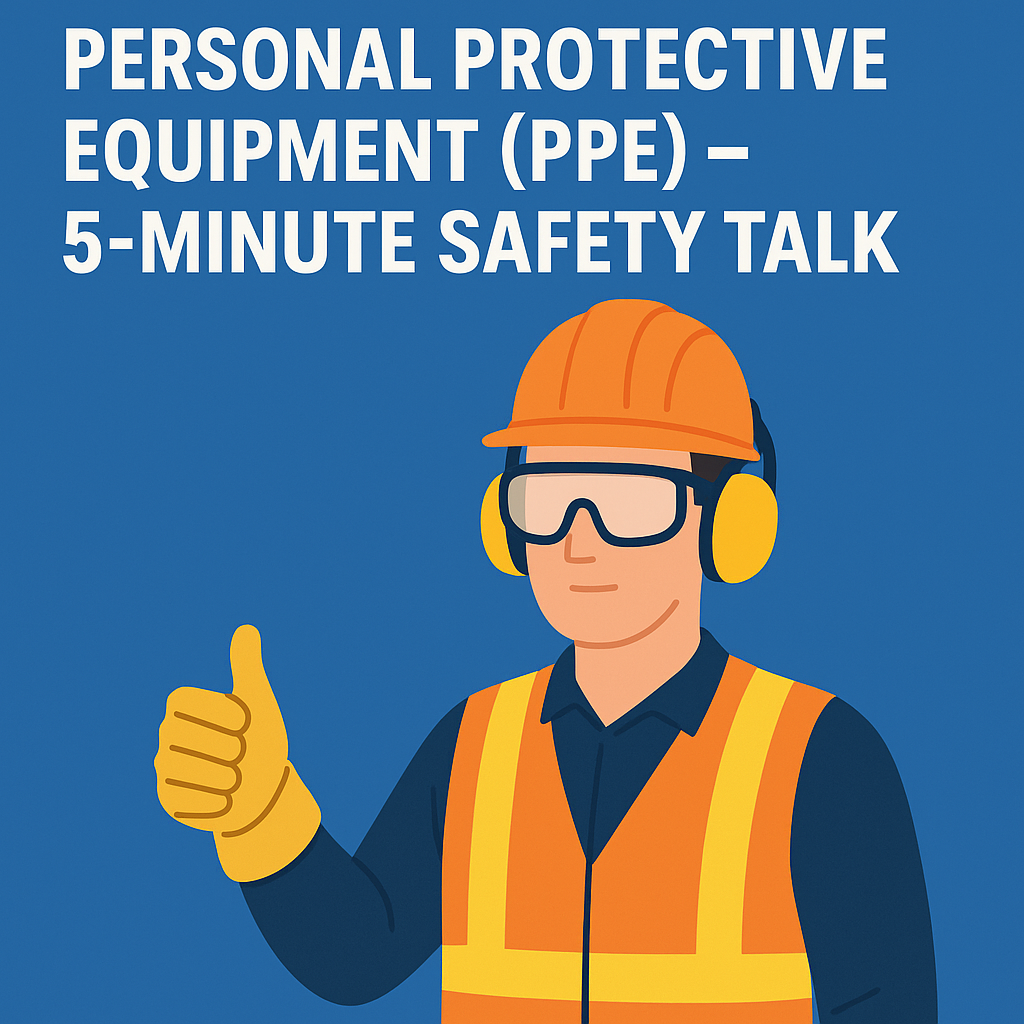
Personal Protective Equipment – PPE 5 Minute Safety Talk
Good morning team,
Today’s safety talk is all about something that stands between you and a serious injury—Personal Protective Equipment, or PPE.
Whether you’re on a construction site, in a warehouse, or working with chemicals or machinery, PPE acts as your last line of defense when other safety measures can’t eliminate a hazard. But just wearing it isn’t enough—you need to use the right PPE, use it properly, and maintain it too.
So let’s take five minutes to refresh our knowledge on how PPE keeps us safe and what we need to do every day to use it correctly.
What Is PPE?
PPE stands for Personal Protective Equipment. It includes any gear or clothing designed to protect you from specific workplace hazards.
Examples include:
- Helmets for head protection
- Safety glasses or goggles for eye protection
- Ear plugs or earmuffs for hearing protection
- Gloves for hand safety
- Respirators for breathing protection
- Steel-toed boots for foot protection
- High-visibility vests for visibility on site
- Coveralls or aprons for full body protection
Why Is PPE Important?
Even with engineering controls and safe work practices, some hazards still remain. PPE protects you from:
- Flying debris
- Hazardous chemicals
- Noise exposure
- Falling objects
- Sharp edges
- Hot surfaces
- Electrical shock
When used properly, PPE helps prevent injuries that could range from minor cuts to life-threatening accidents.
Common Mistakes When Using PPE
Many workers get hurt not because they didn’t have PPE—but because they didn’t use it correctly. Common mistakes include:
- Wearing the wrong type of PPE
- Not inspecting it before use
- Using damaged or dirty equipment
- Removing PPE too early
- Not wearing it at all for “just a quick task”
PPE is only effective when it’s used properly and consistently.
Always Inspect Before You Use
Before starting your job, always check your PPE for:
- Cracks, holes, or tears
- Broken straps or fasteners
- Missing parts or signs of wear
- Dirt or contamination
If it doesn’t look or feel right—report it and replace it. Never risk your safety with faulty gear.
Match PPE to the Hazard
Not all PPE is created equal. You need the right gear for the job:
- Working with chemicals? You need chemical-resistant gloves, apron, and goggles.
- Grinding or cutting? You’ll need eye and face protection.
- Loud environment? Use proper hearing protection.
- Working at heights? A fall arrest harness is essential.
Always assess the risk—and match your PPE accordingly.
Keep It Clean and Stored Right
PPE doesn’t last forever. To make it last and work properly:
- Clean it after use as per manufacturer’s instructions
- Store it in a clean, dry place
- Don’t share PPE unless it’s sanitized
- Report damage immediately
Well-maintained PPE performs better and keeps you safer.
PPE Is Not Optional
Sometimes we hear, “It’s too hot to wear gloves,” or “I’ve done this job a hundred times.” But no task is too small or too quick for proper PPE.
The rule is simple: If there’s a risk—there should be PPE.
Quick PPE Checklist
Before you begin your shift, ask yourself:
- Do I know what PPE I need for today’s tasks?
- Is my PPE clean and in good condition?
- Am I wearing it correctly?
- Do I know how to use and remove it safely?
- Is backup PPE available if something breaks?
If you’re unsure—ask your supervisor or safety officer.
Your Responsibility
PPE is personal—which means it’s up to you to make sure it’s worn and maintained correctly. Don’t depend on others to check it for you. Your safety starts with your choices.
And if you ever see someone not wearing required PPE, speak up. You might just prevent a serious injury.
Real-Life Example
A worker once decided to skip wearing safety goggles during a short grinding task. Just a couple of minutes in, a metal shard flew into his eye. The result? Emergency surgery and permanent vision loss in one eye.
That’s how fast it can happen. That’s why PPE matters.
Conclusion
To sum up, PPE is your last layer of protection—the barrier between you and the hazard. It’s not a suggestion. It’s not a backup plan. It’s a life-saving habit.
So, suit up properly. Inspect it. Use it correctly. And never take it off too soon.
Because at the end of the day, your PPE won’t protect you unless you use it the right way.
Housekeeping 5 Minute Safety Talk
Create Your Own Toolbox Talk Presentation – Step-by-Step
Slips, Trips, and Falls Safety Talk
Fall Protection Systems Safety Talk
Compressed Gas Cylinder Safety Talk
5 Unique FAQs
Q1: What if my PPE doesn’t fit properly?
Tell your supervisor immediately. Ill-fitting PPE is unsafe and must be replaced with the correct size.
Q2: Can I reuse disposable PPE?
No. Items like disposable gloves, masks, or earplugs should be discarded after one use.
Q3: Who is responsible for providing PPE?
In most workplaces, employers are required to provide appropriate PPE free of charge.
Q4: Is it okay to remove PPE for a quick job?
Absolutely not. Many injuries happen during “quick tasks” where PPE is skipped.
Q5: How often should PPE be replaced?
It depends on the type and usage. Some PPE is single-use; others must be replaced when damaged or after a specific time frame. Always follow manufacturer and company guidelines.